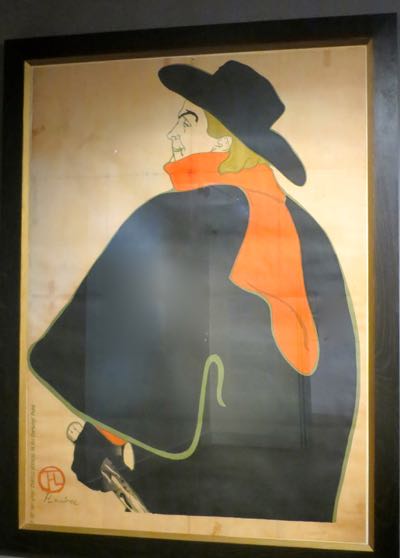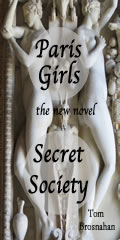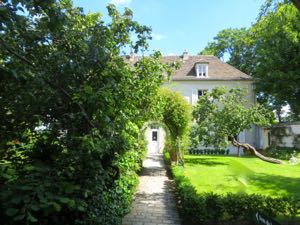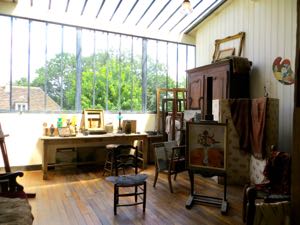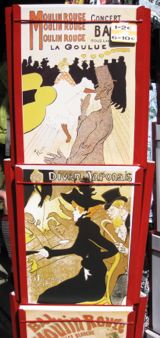 You can buy the posters anywhere, but visit the Montmartre Museum to see the real thing!
|
|
The Musée de Montmartre, a 3-minute walk (240-meter/262-yard) north of Montmartre's Place du Tertre (map), provides a glimpse into the storied past of this famous area of Paris and the many artists who called it home. Tucked away between the Jardins Renoir on the small Rue Cortot, it's only a couple of blocks from the Basilique du Sacré Coeur. Once inside you can leave the hustle and bustle of Montmartre behind and focus on the fascinating history of this area. The Montmartre Museum's collections of paintings and posters, as well as other artifacts, makes the Bohemian life of Montmartre come to life. A variety of artists lived and worked here, ranging from Pierre-Auguste Renoir to Maurice Utrillo to Raoul Dufy. Renoir painted his famous Bal du moulin de la Galette (now in the Musée d'Orsay) while here, as well as La Balançoire, a charming painting of a young girl standing on a swing. The museum has actually recreated the balançoire, or swing, in the gardens, so you can take your own picture if you want. The visit starts with a short film, narrated by model/artist Suzanne Valadon, one of the museum's former residents. This film helps set the scene for what you will see. Begin your visit by walking through the gardens to the main house, down some steps through the gardens. If you want, you can continue down more steps and see the famed Montmartre Vineyard, and just across the street from it, the Lapin Agile. Montmartre was a big wine producer for many years; today just one vineyard remains. Created in 1933, the vineyard allows Montmartre to celebrate the Fête des Vendanges every fall, including pressing grapes in the basement of the town hall of the 18th arrondissement. The limited production is sold, with proceeds going to charity. Entering the museum, you'll wander through the small rooms of the charming old house, seeing paintings by Utrillo, exhibits about Le Chat Noir, considered the first modern cabaret, and much more. Composers including Claude Debussy and Erik Satie worked and performed there. There are also examples of the famous shadow puppets that were used in many of the productions. The iconic poster of the black cat with its Byzantine "halo," by Théophile-Alexandre Steinlen, is seen frequently around Montmartre (see below, right). The museum also has a number of original posters by Toulouse-Lautrec, which will look familiar because you've already seen them in souvenir shops across Paris. His various portrayals of singer/composer/nightclub owner Aristide Bruant, characterized by his black hat and red scarf, are known around the world. You'll also see the famous painting of the Lapin Agile, by André Gill, which gave the name to the nearby Montmartre cabaret. (Below, right) And if you want to know all about the can can, this is the place to come! Descriptions, photos, and even film excerpts position this exciting dance prenomenon that started in Montmartre. (In the nearby Montmartre Cemetery you can see the grave of La Goulue, Louise Weber, credited with "inventing" the can can. Her rival Jane Avril (buried in Père Lachaise) may disagree.) When you've finished in the main building, be sure to walk across the gardens (where there's a small tea room called the Café Renoir if you want a coffee or snack). Enter the other building and climb the stairs to enjoy the changing array of special exhibits. When we visited there was a focus on Montmartre artists and Erik Satie, and an exhibit on Bernard Buffet was set to open. Be sure to go to the end of the exhibit and through the door leading to the studio of Suzanne Valadon and her son, Maurice Utrillo. Furnished as it would have been, and enjoying wonderful light, it gives a good sense of how the artists might have worked. Sadly, the nearby Bateau Lavoir, where Picasso painted Les Demoiselles d'Avignon, burned in 1970. This served as a club house for artists and writers including Matisse, Modigliani, Utrillo, Apollinaire, Cocteau, and many more. In addition to being an important base and inspiration for artists, writers, and musicians, Montmartre became a center of night life and clubs, because it was not subject to the same taxes and tolls that Paris was. Once it became an official part of Paris, Montmartre continued to be a center of night life but had to put up with competition from Montparnasse and other emerging areas. You'll also learn about some other aspects of the history of Montmartre, which was a major gypsum quarry. Gypsum was used in plaster for buildings and also for setting bones—thus Plaster of Paris really did come from Paris! Visiting the Musée de Montmartre, it's easy to forget about the crowds and activity in the center of Montmartre. Let yourself be taken back in time to appreciate the vibrant and creative culture that was Montmartre, where many of the artists and writers you enjoy today created their communities and thrived. And then, back into the 21st century, but with a perspective on its roots. Métro: Lamarck-Caulaincourt or Abbesses; Anvers (plus funicular) Open every day; free audio guide available. Does not accept the Paris Museum Pass. Musée de Montmartre
|
|
Above, The lovely Montmartre Museum, Paris.
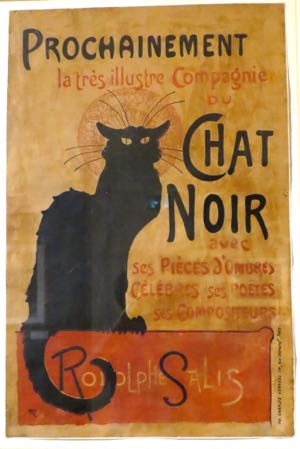 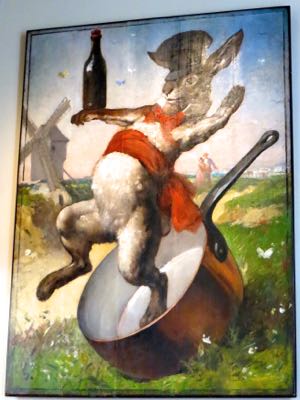 |

